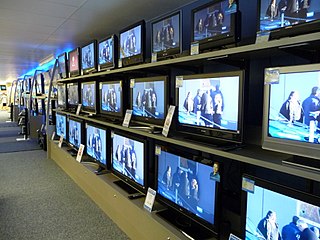The media of Nicaragua consist of several different types of communications media: television, radio, cinema, newspapers, magazines, and Internet-based Web sites. [1]

Television (TV), sometimes shortened to tele or telly, is a telecommunication medium used for transmitting moving images in monochrome, or in color, and in two or three dimensions and sound. The term can refer to a television set, a television program, or the medium of television transmission. Television is a mass medium for advertising, entertainment and news.

Radio is the technology of signaling or communicating using radio waves. Radio waves are electromagnetic waves of frequency between 30 hertz (Hz) and 300 gigahertz (GHz). They are generated by an electronic device called a transmitter connected to an antenna which radiates the waves, and received by a radio receiver connected to another antenna. Radio is very widely used in modern technology, in radio communication, radar, radio navigation, remote control, remote sensing and other applications. In radio communication, used in radio and television broadcasting, cell phones, two-way radios, wireless networking and satellite communication among numerous other uses, radio waves are used to carry information across space from a transmitter to a receiver, by modulating the radio signal in the transmitter. In radar, used to locate and track objects like aircraft, ships, spacecraft and missiles, a beam of radio waves emitted by a radar transmitter reflects off the target object, and the reflected waves reveal the object's location. In radio navigation systems such as GPS and VOR, a mobile receiver receives radio signals from navigational radio beacons whose position is known, and by precisely measuring the arrival time of the radio waves the receiver can calculate its position on Earth. In wireless remote control devices like drones, garage door openers, and keyless entry systems, radio signals transmitted from a controller device control the actions of a remote device.

Film, also called movie or motion picture, is a medium used to simulate experiences that communicate ideas, stories, perceptions, feelings, beauty or atmosphere by the means of recorded or programmed moving images along with other sensory stimulations. The word "cinema", short for cinematography, is often used to refer to filmmaking and the film industry, and to the art form that is the result of it.
Contents
- History of Nicaraguan media
- Domination of the print media
- Television
- Terrestrial television channels
- Cable television channels
- Print media
- Newspapers
- Magazines
- Radio
- Internet
- See also
- References
- External links
Freedom of speech is a right guaranteed by the Constitution of Nicaragua. There is no official state censorship of the media in Nicaragua. [2]

The Constitution of Nicaragua was reformed due to a negotiation of the executive and legislative branches in 1995. The reform of the 1987 Sandinista Constitution gave extensive new powers and independence to the National Assembly, including permitting the Assembly to override a presidential veto with a simple majority vote and eliminating the president's ability to pocket veto a bill. Both the president and the members of the unicameral National Assembly are elected to concurrent five-year terms.

Nicaragua, officially the Republic of Nicaragua, is the largest country in the Central American isthmus, bordered by Honduras to the northwest, the Caribbean to the east, Costa Rica to the south, and the Pacific Ocean to the southwest. Managua is the country's capital and largest city and is also the third-largest city in Central America, behind Tegucigalpa and Guatemala City. The multi-ethnic population of six million includes people of indigenous, European, African, and Asian heritage. The main language is Spanish. Indigenous tribes on the Mosquito Coast speak their own languages and English.










